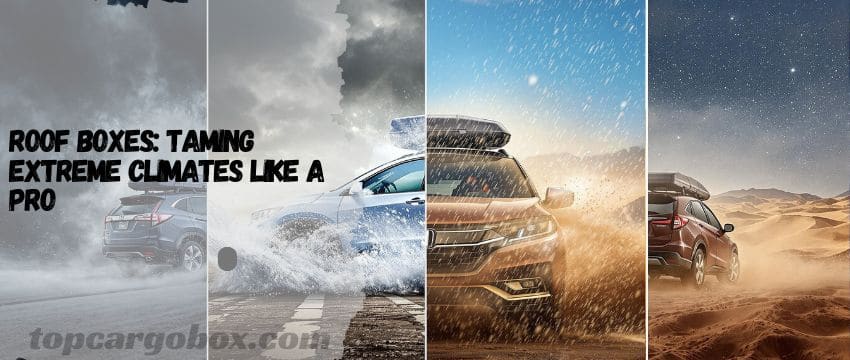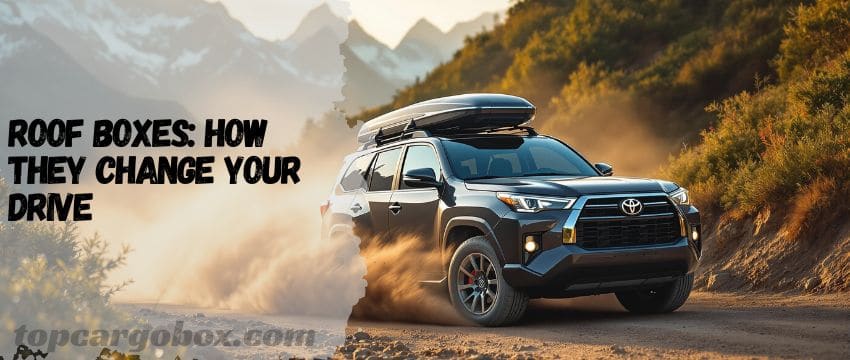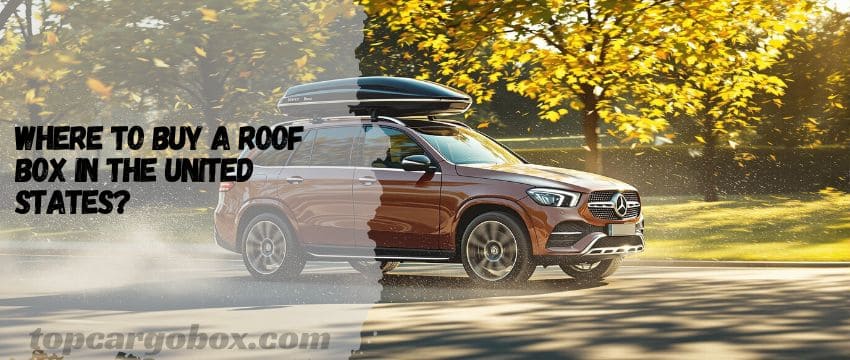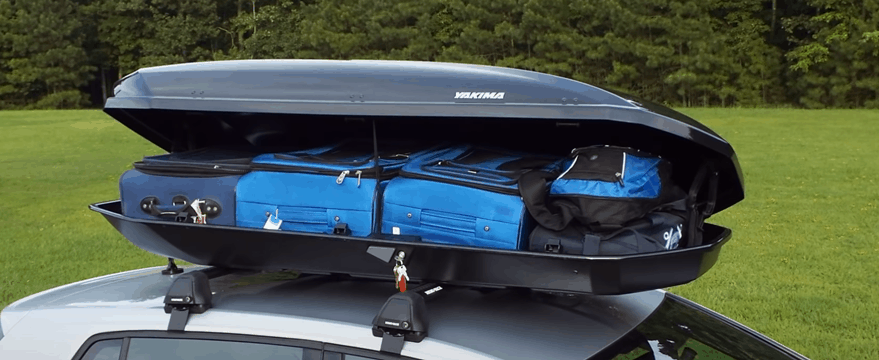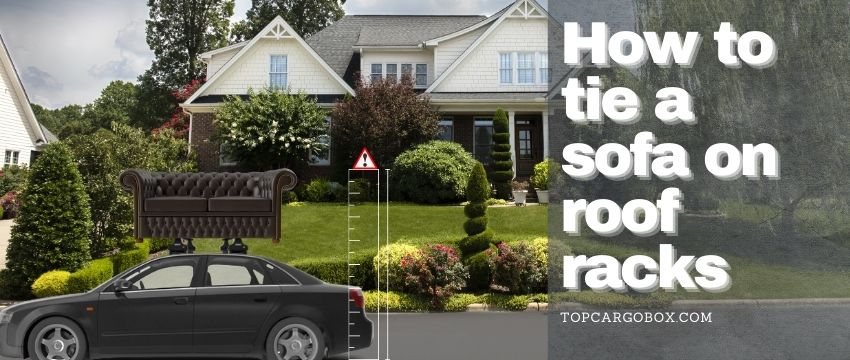What’s up, adventure seeker? So, you’ve got that epic road trip planned – maybe chasing powder in the Rockies, exploring desert canyons, or tackling coastal highways. Your car’s packed, but let’s be real, you still need more space for the skis, boards, camping gear, or the kids’ stuff. That’s where the trusty car roof box comes in, right? Totally get it. But hold up! If your journey involves seriously hot, freezing cold, salty air, or howling winds, slapping any old box up there could lead to some major headaches. What if your gear gets ruined, the box cracks, or your fuel efficiency tanks worse than a snowdrift? That sucks. This guide is your ultimate playbook for conquering extreme climates with a roof box. We’re diving deep into the heat, the cold, the salt, the wind – everything you need to know to keep your gear safe and your ride smooth, no matter what Mother Nature throws your way. Let’s get into it!
Why Extreme Climates Demand Extra Attention
Okay, picture this: you’re cruising through Death Valley, sun blazing down, and your roof box is basically baking like an oven up there. Or imagine parked overnight in the Yukon, where temps plunge to negative 30 degrees Fahrenheit. Brutal. Standard roof boxes are built tough, sure, but these conditions? They’re next level, dude. Extreme heat can soften plastics, warp components, and literally cook whatever’s inside. Extreme cold makes materials brittle as glass, prone to cracking if you even look at them wrong. Then there’s coastal salt spray eating away at locks and hinges like tiny, evil robots, or hurricane-force winds trying to rip your box clean off the rails. How’s your current box holding up thinking about that? Choosing the right box and prepping it properly isn’t just about convenience; it’s about protecting your investment in the box and your precious cargo. Trust me, finding your ski boots melted or your camping gear frozen solid is a serious bummer we want to avoid.
Battling the Blazing Sun and Scorching Heat
Alright, let’s talk heat. That sun beating down on your car roof? It turns the space inside your roof box into a mini-sauna, easily hitting temperatures way higher than the outside air. I’m talking 150 degrees Fahrenheit or more! Can you even imagine? Plastics not specifically designed for this can soften, lose their shape, or become super brittle over time. UV rays are the real silent killers, relentlessly breaking down materials, fading colors, and making everything look old and tired way too fast. Your gear inside suffers too – think warped skis, melted plastic items, or electronics getting fried. Not awesome. So, what’s the move? Look for boxes made with high-density polyethylene (HDPE) or ABS plastic blended with UV inhibitors. These bad boys laugh in the face of sun damage. Light colors like white or silver? Totally your best friends; they reflect heat instead of absorbing it like dark colors do. Ventilation is clutch too – some boxes have clever vents to let that hot air escape. And hey, whenever you can, park in the shade. Every little bit helps save your box and your stuff from turning to toast.

Conquering Sub-Zero Freezes and Icy Conditions
Brrr! Freezing temps are a whole different beast. When the mercury drops way down, the materials your roof box is made of contract and can become incredibly brittle. Ever tried bending plastic when it’s super cold? It snaps! That sudden impact from closing the lid on a frozen seal, hitting a rogue branch covered in ice, or even just driving over a rough patch can lead to cracks or splits. Major yikes. Then there’s the internal moisture situation. Warm, moist air from your gear rises, hits the cold box lid, and BAM – instant frost or even ice accumulation inside. Open it up, and it’s like a mini snowstorm falling on your stuff. Double bummer. Locks and mechanisms can freeze solid too, leaving you wrestling with your box in a parking lot at negative 10. No thanks! Choosing a box built with cold-flex materials is non-negotiable for serious winter use – these stay pliable down to crazy low temps. Silicone-based lubricants for locks and seals (applied before it gets cold!) are lifesavers. And get this: letting the box warm up slightly (like parking in a slightly warmer garage for a bit) before trying to open it can prevent that brittle plastic from cracking. Patience is key!
Surviving Coastal Salty Air and Humidity
Heading to the beach? Sounds awesome, until you remember the salty, humid air is basically kryptonite for metal parts. Coastal environments are brutal on roof boxes. That salty mist gets everywhere – into the locks, hinges, mounting hardware, and latches. It causes corrosion faster than you can say “rust bucket.” Before you know it, your key won’t turn smoothly, hinges squeak like a haunted house, and bolts start looking furry and orange. It’s a real pain. High humidity alone can encourage mold and mildew inside the box if your gear wasn’t perfectly dry when packed. Who wants to unpack musty, salty gear? Not me! Prevention is everything here. Opt for boxes featuring stainless steel hardware and corrosion-resistant locking mechanisms. Seriously, don’t skip this. Giving all the moving parts a good rinse with fresh water after every coastal trip washes away the salt. Letting the box dry thoroughly before storing it (maybe even wiping it down inside) stops mold before it starts. Applying a marine-grade lubricant to locks and hinges periodically is like giving your box a shield against the salty onslaught. Your future self will thank you.

Handling High Winds and Driving Dynamics
Let’s be real, slapping a giant box on your roof changes how your car handles, especially when the wind starts howling. Aerodynamics take a serious hit. That sleek profile? Gone. You’re basically driving a brick wall on top of your car. The result? Increased wind noise (like, really loud sometimes), more drag making your engine work harder, and a noticeable drop in fuel efficiency – we’ll talk numbers later, but yeah, it’s legit. In super gusty conditions, like mountain passes or open plains, that box can catch the wind like a sail, making your car feel less stable. You might feel it pulling or causing slight sway. Not exactly confidence-inspiring. Choosing a sleek, aerodynamically designed roof box makes a world of difference. Think teardrop shapes and low profiles – they slice through the wind way better than bulky, square designs. Securing your load tightly inside the box prevents shifting that can throw off your car’s balance. And hey, always double-check those mounting points are locked down solid before hitting the highway, especially on windy days. Driving a bit slower and smoother in high winds is just smart.
Choosing the Champion: Key Features for Extreme Climate Boxes
Alright, so what exactly should you look for when your roof box needs to be a climate warrior? Off the top of my head, the material is king. UV-stabilized, high-density polyethylene (HDPE) is the gold standard for heat and cold resilience. It’s tough, flexible when cold, and resists sun damage like a champ. ABS plastic can work, but ensure it’s high-quality and specifically UV-treated – cheaper ABS in extreme heat is asking for trouble. Locking mechanisms need to be robust and corrosion-resistant. Look for stainless steel components or high-quality, coated metals. The seal is your cargo’s best friend – a thick, durable, cold-flex gasket is essential for keeping moisture (rain, snow, humidity) and dust out, even under pressure from shifting loads or temperature changes. Aerodynamics matter hugely for wind and efficiency – a sleek, tapered design minimizes drag and noise. Finally, consider ease of use: dual-side opening is super convenient for loading, and secure mounting systems that are easy to check give you peace of mind. Don’t just grab any box; get the right tool for the extreme job.
Top Performer Specs at a Glance
Feature | What to Look For in Extreme Climates | Why It Matters |
|---|---|---|
Material | UV-Stabilized HDPE (Best) or Premium UV-Treated ABS | Withstands heat warping, UV fading, and cold brittleness. |
Color | White, Silver, Light Grey | Reflects heat significantly better than dark colors. |
Hardware | Stainless Steel or High-Quality Corrosion-Resistant | Prevents rust and seizing from salt air and humidity. |
Seal/Gasket | Thick, Silicone-Based, Cold-Flexible | Maintains watertight seal in freezing temps and heavy rain. |
Shape | Aerodynamic, Tapered, Low-Profile Design | Reduces wind drag, noise, and fuel consumption; improves stability. |
Ventilation | Integrated Ventilation Systems (Passive or Active) | Allows hot air to escape, reducing internal temps. |
Locking | Central Locking System with Reinforced Points | Provides security and ease of use; resists jamming. |
Load Capacity | Matches your vehicle roof load limit & your needs | Ensures safety and prevents overloading roof rails. |
Pre-Trip Prep: Getting Your Box Ready for Battle
You wouldn’t head into a blizzard without checking your gear, right? Same goes for your roof box facing extreme conditions. Before you load up, give the whole box a solid once-over. Check for any existing cracks, especially around mounting points and stress areas – even tiny ones can become big problems under stress or cold. Clean the seals meticulously with mild soap and water, then treat them with a silicone-based lubricant (avoid petroleum-based, it can degrade rubber!). This keeps them pliable and sealing perfectly in heat or cold. Test the locks multiple times – make sure they turn smoothly and latch securely. Sticky lock in your driveway? Fix it now, not later in a frozen parking lot! How’s the mounting hardware? Ensure all clamps, bolts, and feet are tight, rust-free, and functioning perfectly. Give the box interior a quick wipe-down too. Taking 20 minutes for this check can save you hours of frustration and potential disaster on the road. Feeling prepared? That’s awesome.

Loading Smart: Protecting Your Gear Inside
How you pack that box is just as crucial as the box itself, especially when dealing with wild temperature swings or bumpy roads. First rule: Distribute weight evenly, especially side-to-side. Heavy items piled on one side? That’s asking for handling issues and stressing the box structure. Keep the heaviest gear centered and low. Use duffel bags, cargo nets, or adjustable straps inside the box to secure everything tightly. Shifting gear creates internal impacts and can damage the box walls or your belongings. For moisture-sensitive stuff (sleeping bags, clothes, electronics), heavy-duty waterproof dry bags are worth their weight in gold inside the roof box – it’s a double layer of protection. In freezing temps, avoid packing items that are damp; they will freeze and potentially cause frost buildup. And please, please respect the weight limit of both your roof box and your vehicle’s roof rails (check your car manual!). Overloading is dangerous and puts immense stress on everything. Pack smart, pack secure.
On the Road: Driving Tips for Extreme Weather
You’re loaded, locked, and ready to roll. Sweet! But driving with a roof box, especially in harsh conditions, needs some adjustments. First up, speed. That aerodynamic drag we talked about? It increases exponentially the faster you go. Driving 65 mph instead of 75 mph can make a surprisingly big difference in fuel economy and wind noise. Plus, it gives you more reaction time. High winds? Grip that wheel a bit tighter and anticipate gusts, especially when passing trucks or going through open areas. Your car will feel different. Be extra cautious on curves and during lane changes – take them smoother. Fuel range takes a hit; don’t push your luck assuming you’ve got the same miles left as usual. Plan for more frequent gas stops. Keep an ear out for any new or unusual noises from the roof – a sudden change could indicate something’s loose. And if you hit truly horrific weather? Like, whiteout blizzard or sandstorm levels? Finding a safe place to pull over until it passes might be the wisest move. Better safe than sorry, dude.
After the Adventure: Care and Storage
You made it! Epic trip, killer memories. Now, don’t just chuck the roof box in the garage and forget about it until next year. That’s how problems start. Give it a proper clean, inside and out, with mild soap and water. Get rid of all the dirt, grime, salt residue, and dead bugs. Rinse it thoroughly and let it dry completely – I mean totally dry, inside and out, especially the seals. Storing it wet is begging for mold and mildew. Inspect it again for any damage incurred during the trip – hairline cracks, seal issues, lock problems. Better to find them now. Applying another round of silicone lubricant to the seals and locks before storage keeps them happy. Now, storage itself: Ideally, keep it indoors (garage, basement, shed) away from direct sunlight and extreme temperature fluctuations. If you must store it outside, invest in a breathable, UV-protective cover designed for roof boxes. Storing it properly is how you get years of reliable service, even after brutal adventures. Check out our dedicated guide on how to store your car roof box for more pro tips.
Vehicle Matchmaking: Getting the Right Fit
Not every roof box plays nice with every car. Putting a massive box on a tiny hatchback? Probably not a great look or safe. You gotta check your vehicle’s roof load capacity – it’s in your owner’s manual, usually listed in pounds or kilograms. This includes the weight of the roof rack system and the loaded box. Exceeding this is dangerous and can damage your roof. Then there’s the physical fit. The box shouldn’t hang way over your windshield or way past the rear of the car roof. It can obstruct your view or lights and just looks awkward. Measure your roof’s usable length and consider the box length carefully. Also, think about your garage height with the box mounted! Finding the perfect fit ensures safety, functionality, and avoids scraping your box (or garage door!). Need ideas? We’ve got guides for popular models like the Subaru Outback, Toyota Highlander, Subaru Crosstrek, Toyota RAV4, and even the Honda Odyssey. Low-profile options, like the skinny, thinnest cargo boxes, are great for garages and efficiency.
Beyond the Basics: Special Considerations
Alright, let’s cover a few more niche but important points. What about keyless boxes? The convenience is tempting, but in extreme cold, mechanical locks can freeze, so keyless systems using coded latches or Bluetooth might seem appealing. However, ensure they are equally robust and weatherproof – electronics failing in the cold is a real risk. Check out options for open roof cargo boxes without keys but research their cold-weather performance reviews carefully. Security is always a concern, especially in remote areas. While a determined thief can get into anything, a sturdy lock and perhaps even a secondary cable lock through the box’s internal anchor points adds a deterrent. Parking in well-lit areas helps. Long-Term Exposure: If your box lives on your car year-round in a harsh climate (intense sun, constant salt air), expect accelerated wear. You’ll need to clean, lubricate, and inspect it way more often. Weight Distribution Sensors: Some high-end boxes or racks have these – cool tech, but ensure they are rated for the temperature extremes you face. When in doubt, keep it simple and ultra-reliable.

Your Roof Box Questions Answered
Okay, you’ve got questions? Totally fair. Let’s tackle some of the big ones head-on.
How much range do you lose with a roof box?
Honestly, it depends, but expect a hit. Aerodynamic drag is the main culprit. A bulky box can easily reduce your fuel economy (or electric vehicle range) by 10-25%, sometimes more if it’s huge or you drive fast. Cruising at 65 mph instead of 75+ mph helps a lot. Sleek, aerodynamic boxes like these aerodynamic rooftop cargo boxes minimize the loss better than square ones. Driving speed is the biggest factor – slower is more efficient. Headwinds also make the penalty worse. It’s a trade-off for the extra space, so plan fuel stops accordingly on long trips.
Do roof boxes get stolen?
It happens, but it’s not super common like catalytic converters. Most boxes are locked to your roof rack, requiring specific tools and time to remove, which is a deterrent. Thieves usually want quick, easy grabs. Using a box-specific lock and parking in well-lit, secure areas significantly lowers the risk. A secondary cable lock threaded through the box’s internal anchor point and around a roof bar adds another layer of hassle for thieves. While not theft-proof, a securely mounted, locked box isn’t the easiest target out there.
Can a roof box be too long for a car?
Absolutely, yes. It shouldn’t obstruct your front windshield view or hang so far back it blocks your rear lights or license plate (that’s often illegal!). More importantly, it needs to fit securely between your roof rack crossbars without overhanging excessively at either end. Check your vehicle’s specific recommendations and measure your roof’s usable space. A box that’s too long can also put uneven stress on the roof rack system. Finding the right fit is crucial for safety, legality, and practicality.
Do roof boxes damage your car?
Not if used correctly! The key is respecting the weight limits (both the box’s and your car’s roof load capacity) and ensuring the mounting system (racks, feet, clamps) is compatible and properly installed. Overloading or using a damaged rack system can potentially dent the roof or cause stress points. Poorly adjusted clamps might scratch the paint over time. As long as you follow the instructions for both your roof rack and the box, and don’t exceed weights, your car will be perfectly fine. No big deal when done right.
How much drag does a roof box add?
Here’s the rewritten version focusing on that drag explanation, keeping it real and conversational:
Feel that extra grunt your engine makes with a box up top? Totally normal, dude. That roof carrier basically turns your slick ride into a total drag monster, and yeah, that’s the main reason you’re hitting the gas station way more often. It’s like your car suddenly has to push a giant barn door through the air instead of slicing through it. How much extra effort are we talking? Well, it really depends on what kind of box you’ve strapped on and how fast you’re flying down the highway. Picture this: a huge, square cargo box when you’re cruising at 80 mph? Whoa, that creates massive wind resistance compared to a smaller, sleek design at a more chill 60 mph. That extra drag? It’s pure physics – your engine (or battery if you’re rolling electric) has to work overtime to fight it, burning through fuel or juice way quicker than normal. Ever feel like you’re just pouring money straight out the tailpipe? That’s the drag tax.
So, what’s the fix? Choosing wisely makes a huge difference, for real. You can’t eliminate the drag completely – nice try, physics – but you can seriously minimize how much it sucks your wallet dry. Grabbing a low-profile box with a smooth, tapered shape – think sleek torpedo profile instead of a brick – cuts through the wind way better. It’s all about helping the air flow over it cleanly instead of slamming into a flat wall. The difference in how hard your engine struggles, and how often you see that fuel gauge dip, can be pretty surprising. It’s legit the smartest move to keep your adventure budget from getting totally wrecked by wind resistance alone. Why pay more at the pump than you absolutely have to, right?
Is it illegal to have a roof box?
Generally, no, having one is perfectly legal. However, there are rules! The loaded box (including contents) must not exceed your vehicle’s roof load limit. It absolutely cannot block your view (front or rear) or obscure your lights, brake lights, turn signals, or license plate. Some places might have specific regulations about how far it can overhang the front or rear bumper. As long as your box is securely mounted, within weight limits, and doesn’t obstruct anything critical, you’re good to go legally. Just drive sensibly!
Gearing Up for Anything
So, there you have it, the full lowdown on conquering deserts, mountains, coasts, and blizzards with your car roof box. It’s not rocket science, but paying attention to the details makes all the difference. Choosing the right tough-as-nails box built for extremes, prepping it like a pro before you go, loading it smartly, driving with awareness, and giving it some TLC afterwards – that’s the winning formula. Yeah, there might be a slight MPG hit or some extra wind noise, but the freedom to bring all your gear, comfortably and securely, on those epic journeys? That’s totally worth it. Imagine pulling up to the trailhead or campsite with everything you need, ready for whatever adventure awaits. No stress, no damaged gear, just pure stoke. Get out there, explore those wild places, and do it with confidence knowing your roof box game is dialed. Safe travels, dude! Catch you on the road.
Our team is creating outdoor-gear relevant articles with passion. If our articles can help you to find the correct solutions for your questions, we will be happy about that. In the content creation process, we usually collect accurate and useful information online or offline to compile our content in an organized way. Consequently, we can guarantee that you can discover some expected answers to your questions. We appreciate your time on our site.

